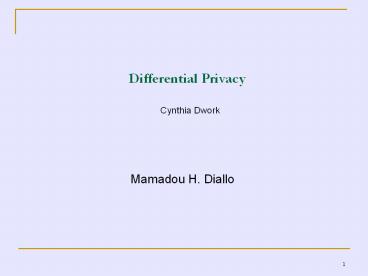Differential Privacy - PowerPoint PPT Presentation
Title:
Differential Privacy
Description:
... the impossibility result Define differential privacy Relate differential privacy to some previous work * Private Data Analysis: ... data perturbation, ... – PowerPoint PPT presentation
Number of Views:325
Avg rating:3.0/5.0
Title: Differential Privacy
1
Differential Privacy
- Cynthia Dwork
Mamadou H. Diallo
2
Overview
- Focus
- Privacy preservation in statistical databases
- Goal to enable the user to learn properties of
the population as a whole, while protecting the
privacy of the individuals in the sample - Motivating problem
- How to reveal useful information about the
underlying population, as represented by the
database, while preserving the privacy of
individuals - Previous techniques too powerful
- Approach
- First define privacy goals, then explore utility
- Prove the impossibility result
- Define differential privacy
- Relate differential privacy to some previous work
3
Private Data Analysis The Setting
- Privacy mechanisms models
- Interactive
- Data collector is trusted
- Data collector publishes sanitized data
- Sanitization techniques data perturbation,
sub-sampling, removing identifiers - Non-interactive
- Data collector is trusted
- Data collector provides an interface
- Users pose queries about the data
- Users get noisy data
- State
- Powerful results for the interactive approach
- But, less results for the non-interactive approach
4
Impossibility of Absolute Disclosure Prevention
- Dalenious privacy definition
- Access to a statistical database should not
enable one to learn anything about an individual
that could not be learned without access - Semantic Security for cryptosystems (ciphertext
indistinguishability) - An adversary cannot distinguish pairs of
ciphertexts based on the message they encrypt
(chosen plaintext attack) - Observation
- Semantic security for cryptosystems can be
achieved - But, Dalenious goal, formalized as a relaxed
version of semantic security, cannot be achieved - Obstacle auxiliary information
- Example
- Sensitive information exact height
- Database average height of women of different
nationalities - Adversary access to the DB auxiliary
information - Auxiliary information Terry Gross is two inches
shorter than the average Lithuanian woman - Different between the two utility requirement
5
Impossibility of Absolute Disclosure Prevention
- Settings
- Utility vector w (binary vector with k length,
answers of questions) - Privacy breach Turing machine C
- Input a description of a distribution D, a
database DB, and a string s - Output 1 bit, Wins C(D,DB, s) accepts
- Auxiliary information generator Turing machine
- Input D, DB
- Output z (auxiliary information)
- Adversary gets z
- Has access to DB via the privacy mechanism
- Modeled as communicating Turing machine
- Simulator gets z No access to DB
- Privacy Mechanism Sam()
- Theorem
- Fix any Sam() and C. There is an X and A such
that for all D satisfying assumption 3 and for
all adversary simulators A, PrA(D,
San(D,DB),X(D,DB)) wins - PrA(D,X(D,DB)) wins
?where ? is a suitably chosen (large)
constantThe probability spaces over choices of
DB and coin flips of San, X, A, A.
6
Different Privacy
- From absolute to relative guarantees about
disclosures - Differential privacy
- The risk to ones privacy should not
substantially increase as a result of
participating in a statistical database - Definition
- A randomized function K gives e-differential
privacy if for all data sets D1 and D2 differing
on at most one element, and all S Range(K),
PrK(D1) in S exp(e) x PrK(D2) in S - ObservationPrK(D1) in S / PrK(D2) in S
exp(e)ln(PrK(D1) in S / PrK(D2) in S ) e - Example
- The database consulted by an insurance company
- Should not affect Terry Gross chance of getting
insurance - Definition extension
- Group privacy
- c number of participants
- PrK(D1) in S / PrK(D2) in S exp(ec)
7
Achieving Differential Privacy
- A concrete interactive privacy mechanism
achieving e-differential privacy - Query function f (simple or complex)
- Database X
- Answer af(X)
- Exponential Noise and the L1-Sensitivity
- Sensitivity random noise, with magnitude chosen
as a function of the largest change a single
participant could have on the output to the query
function - Definition for f D ---gt Rd, the L1-sensitivity
of f is ?f maxD1,D2 f(D1)
f(D2)1Techniques work best when ?f is small - Density functionPrKf(X) a exp(-f(X) -
a1/s) - Theoremfor f D ---gt Rd, the mechanism Kf gives
(Kf/s)-differential privacye-differential
privacy ----gt s e/?f
8
Achieving Differential Privacy
- Adaptive adversary
- f? query functions
- F deterministic query strategies
- f?(X)i the ith query (previous responses ?1,
?2, , ?i-1) - F f D ---gt (R)d
- Sensitivity of F ?F sup? ?f?
- TheoremFor query strategy F f D ---gt Rd,
the mechanism KF gives (?F/s)-differential
privacy.
9
Questions?






























